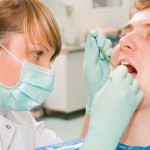
The proportion of older people in the population is rising and because of improvement in oral health more of them as retaining their teeth. Consequentially more people in this age group will have more teeth at risk of caries. Dental service utilization is also lower in older age groups and chronic medial conditions; poly-pharmacy, frailty and transport difficult may increase barriers to dental care. Atraumatic restorative treatment (ART) which has been used extensively in children may provide an alternative approach to dental care in this group of patients. The aim of this study was to evaluate ART in terms of its cost-effectiveness relative to a conventional technique as part of a preventive and restorative dental programme for older adults over a twelve-month period.
Patients ≥ 65 yeas of age with ≥ 1 carious lesion into dentine and able to perform usual daily dental care activities such as toothbrushing were included. They were randomised to receive either ART or conventional treatment (CT). ART involved tooth preparation with hand instruments conditioning with polyacrylic acid for 20 seconds, washing and drying with cotton pellets and restoration with high-strength glass-ionomer cement. Cavity preparation for the CT involved the use of rotary instruments under local anaesthesia prior to placement of resin-modified glass- ionomer. Moisture control techniques were the same in both cases. The average cost per restoration was estimated for both ART and conventional treatment. Effectiveness was measured in terms of the survival percentage of restorations after 1 year.
- 82 patients (40 male; 42 female) participated, aged 65-88
- 260 restorations were placed, 128 ART (44 patients) and 132 CT restorations (38 patients). The majority were single surface (91.1%)
- The average time of procedures was 13.0 minutes for ART and 18.0 minutes for conventional restorations.
- After 12 months, 80 patients and 252 restorations could be assessed
- 91.1% (113/124) of ART restorations were considered successful compared with 97.7% (125/128) of conventional restorations. Failures were mainly due to partial of complete loss of the restoration.
- The average cost per CT restoration was €28.71 compared with €16.86 for ART provided by dentists and €12.76 by a dental hygienist. A cost effectiveness ration of 0.18 for dentists and 0,14 for hygienists.
The authors concluded
Atraumatic restorative treatment was found to be a more cost-effective alternative to treat older adults after 1 year, compared to conventional restorations, especially in out of surgery facilities and using alternative workforce such as hygienists. Atraumatic restorative treatment can be a useful tool to provide dental care for frail and fearful individuals who might not access dental treatment routinely.
Comment
The majority of studies carried out on ART have been in children and in a community or field setting where as this one was performed in a clinical setting. This study shows that after a year failure rates for ART were 6.6% higher than CT although both were in excess of 90%. It would be interesting to see some longer-term results to see if these levels remain similar for both approaches in the years to come. As multiple restorations were place in patients it would have been interesting to see if there were any effects of clustering but there is no information on whether this was considered.
Currently a Cochrane review (Dorri et al) is underway comparing the effects of ART versus conventional treatment in adults and children.
Links
da Mata C, Allen PF, Cronin M, O’Mahony D, McKenna G, Woods N. Cost-effectiveness of ART restorations in elderly adults: a randomized clinical trial. Community Dent Oral Epidemiol. 2013 Aug 19. doi: 10.1111/cdoe.12066. [Epub ahead of print] PubMed PMID: 23952107.
Dorri M, Sheiham A, Marinho VCC. Atraumatic restorative treatment versus conventional restorative treatment for the management of dental caries (Protocol). Cochrane Database of Systematic Reviews 2009, Issue 4. Art. No.: CD008072. DOI: 10.1002/14651858.CD008072.

Atraumatic restorative treatment had good 1-year survival and http://t.co/uvaqAEJsyH via @TheDentalElf Links to Dental Elf on #GDPUK
[…] Dental Elf – 9th Sept 2014 – Atraumatic restorative treatment had good 1-year survival a… […]